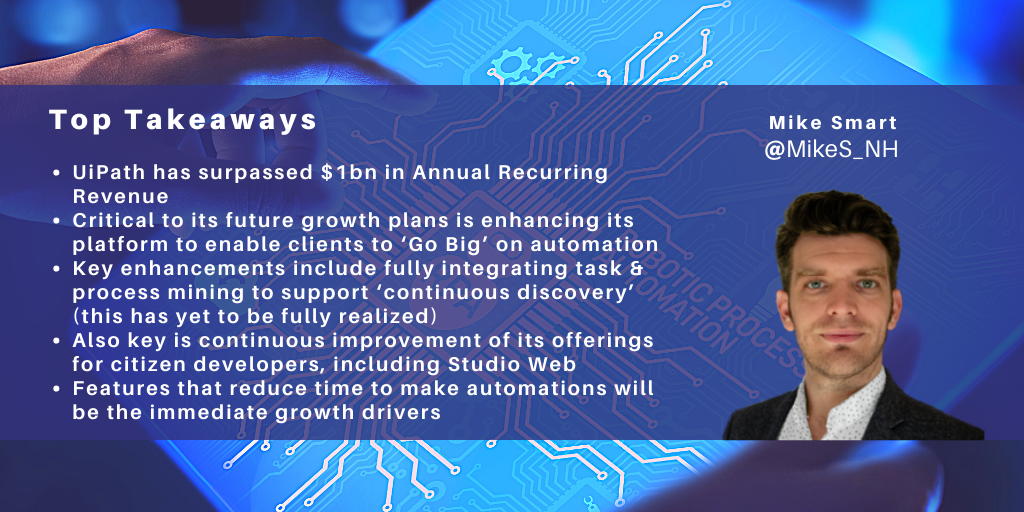Search posts by keywords:
Filter posts by author:
Related NEAT Reports
Other blog posts
posted on Oct 12, 2022 by Mike Smart

NelsonHall recently attended UiPath’s Forward V event in Las Vegas. The company has recently passed $1bn in Annual Recurring Revenue (ARR), up 44% y/y, enabled through its base of 10.5k clients. This includes some very large clients such as Generali, and, similar to the other tier 1 automation platform providers, an exceptionally long tail of clients with <10 bots. UiPath’s messaging focused on how enhancements to its platform will enable clients to ‘Go Big’ on automation and reach the scale of Generali. This will be critical to UiPath’s long-term growth plans.
Continuous discovery with task & process mining
As such, some of the announcements during the event focused on what UiPath calls ‘continuous discovery’. While the company gained task and process mining capabilities through the acquisitions of ProcessGold and StepShot in 2019 (see the Forward III event blog), Chief Marketing Officer Bobby Patrick stated that back then the end-to-end nature of the platform was mostly ‘on paper’ and not in production, as these components had not been fully integrated. The company now states that the platform is fully integrated, allowing users to help clients discover the as-is state of processes, take actions to optimize and automate them, and then continuously monitor them for ongoing improvement.
What, to some degree, still remains on paper is being able to harness the joint capabilities of task mining and process mining to offer a fuller definition of long complicated processes; currently, UiPath has just a few dozen clients using both components. The general feedback from clients at the event was that these components are not being used in a ‘continuous discovery’ manner (i.e. continuously assessing a process over time for further opportunities for automation and efficiency gains). Instead, licenses are being cycled round the client organization with different departments receiving a point-in-time assessment of the process. We expect this to remain the case going forward in all but very rare scenarios, until task mining licenses decrease in cost.
Another recent acquisition is Re:infer, which brings communications mining functionality. Unlike task or process mining, Re:Infer’s focus is solely on electronic communications within client organizations. The platform can analyze emails, chat logs, social messages, and more, to create actionable business data and new opportunities for automation using its NLP engine. Then, when building and running automations, this NLP engine can be used on inbound electronic communications to trigger automations within UiPath.
The use of Re:Infer is in its early days within UiPath, being only in private preview, and (somewhat like ProcessGold and SnapShot in 2019) has not been fully integrated into the platform. NelsonHall envisions that as Re:infer becomes more integrated into the general UiPath platform suite, it will have the opportunity to become the main NLP engine; for example, being integrated into task mining to better understand emails and documents that employees are working on.

Go Big: theme of UiPath’s Forward V event
Enhancing automation development environments
The UiPath platform offers three development environments: Studio is an advanced product for experienced developers, while Studio X and Studio Web are for less experienced developers.
The most notable recent release is Studio Web, a browser-based automation development environment. The concept is not especially new, mirroring Automation Anywhere’s Automation 360 web IDE, but is a welcome one, especially as the company is continuously improving its offering to citizen developers.
Projects being developed on Studio Web can be edited by users on Studio and Studio X, with a target use case being a citizen developer logging into Studio Web, creating an automation, then (when the automation is ready to be proliferated) it can be sent to Studio for a client’s automation CoE to ensure the robustness of the bot.
Incorporated into Studio Web along with Studio and Studio X are ‘document understanding’ advancements. Along with overall enhancements to the extraction engine to support the likes of signature, barcode, QR code, and improved table extraction, UiPath has added native support for verticalized pre-built models for processing tax, insurance, and transportation documents.
Separate to its automation Studios, UiPath has expanded the capabilities of its Apps component to simplify the creation of lightweight applications, and for the first time, allow for the creation of public-facing apps.
UiPath also announced a partnership with outsystems, another low-code application provider. While UiPath believes its low-code application builder is suitable for a wide variety of applications, it has no plans to support high-complexity systems such as CRM applications. In these use cases, the company believes outsystems can fill that gap.
One app created using UiPath Apps and customizable by clients is Automation Launchpad, a springboard to guide client citizen developers through their company’s automation program; for example, providing information on how they may submit an idea.
Lastly, UiPath has added a connection builder to its Integration Service, its enabler of API automation. Similar to the process and task mining capabilities, Integration Service is now supported across all UiPath components, allowing users to use APIs in addition to the suites’ traditional UX automation capabilities. The connection builder allows clients to build connections to in-house and specialized industry solutions.
Conclusion
These advancements will be critical in enabling more use cases for the platform or allowing for easier identification of automation opportunities and more processes that can be automated. Specifically:
- The process understanding module’s integration will support more organizations opting to discover and understand the processes that are ripe for automation
- Re:infer will, as it integrates into the platform, allow for the detection of electronic conversations that have lots of inefficient back and forth
- Public-facing apps opens up the possibility for organizations to develop lightweight citizen-led ways to interact with customers
- And connection builder allows for more API automation.
These features, along with a change in GTM within sales to support clients who represent the best opportunities to become power users, will be the key to supporting the array of clients that currently don’t take advantage of the wide capabilities of the platform. In speaking with clients at Forward V, each and every one had bandwidth capacity issues with, in most cases, hundreds of opportunities for automation to be identified, but a lack of capacity to automate them all. Therefore, NelsonHall believes the immediate growth drivers will be the features that reduce time to make automations; for example, encouraging more citizen development with Studio Web or within testing automation, and migrating test signatures from QA testing platforms such as HP ALM.
